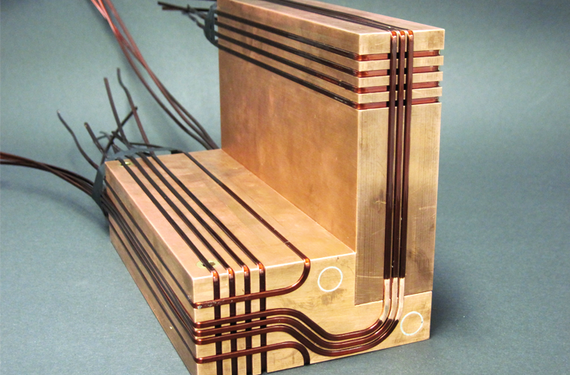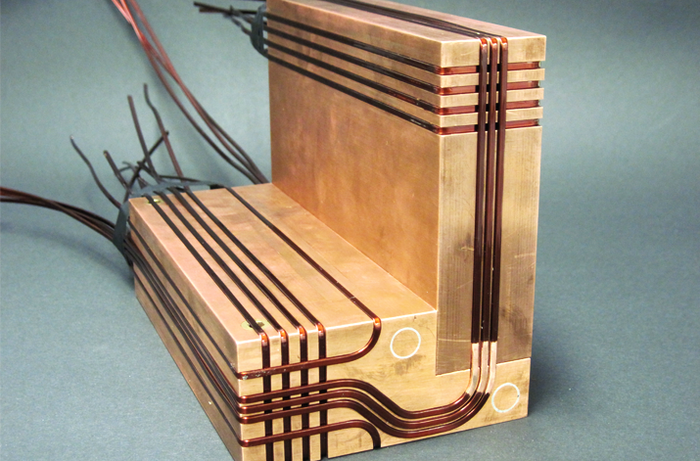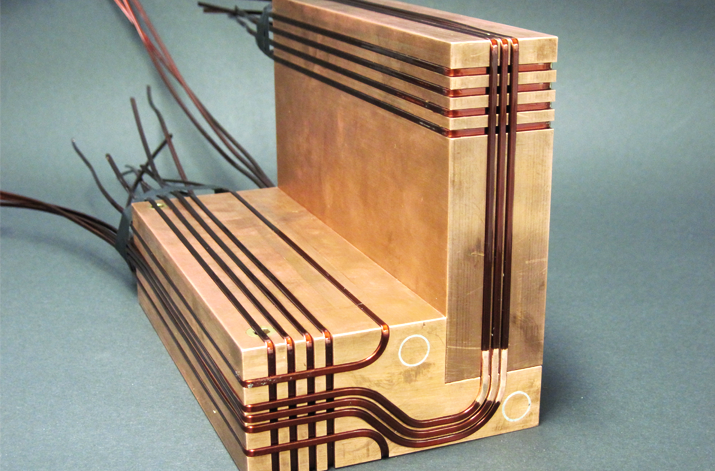

 ©
Institut für Quantenoptik, Carsten Klempt
©
Institut für Quantenoptik, Carsten Klempt
In the past a broad field of research has been established using Bose-Einstein-condensed atomic samples as a versatile example system to measure a multitude of quantum effects.
The Mesoscopic Atom Chip project aims to set up a new apparatus for creating Bose-Einstein-condensed clouds, providing higher repetition rates to overcome the limitations due to the slow cycle times of other BEC machines.
The time limitation for the generation of quantum degenerate ensembles is typically given by the loading cycles of the magneto-optical trap as well as the time needed for evaporative cooling. With an optimized double MOT setup we can decrease the loading time. The time needed for evaporation will not be a limitation in our apparatus since we will be able to store and transport multiple atomic ensembles and evaporate them simultaneously.
Therefore current carrying planar wire structures were developed to generate the magnetic fields used for magneto optical cooling as well as magnetic trapping and transporting of multiple ultra cold Rb-87 clouds. With this concept one could either produce rapid replenishing BEC or combine a chain of ultra cold clouds in one trap to obtain one BEC consisting of many atoms.
Experiment
-
Overview
The experimental apparatus consists of a two dimensional magneto optical trap generating a cold atomic beam to load a three dimensional magneto optical trap (3D-MOT). The magnetic fields of the 3D-MOT are realized exclusively by the planar wire structures of a mesoscopic atom chip. Afterwards the atoms are transported within a chain of magnetic traps. During this transport the atoms will be evaporatively cooled down to quantum degeneracy.
-
Laser System
![Optical setup]()
![Optical setup]()
![Optical setup]() ©
Institut für Quantenoptik, Carsten Klempt
©
Institut für Quantenoptik, Carsten Klempt
![Schematic of the laser system]()
![Schematic of the laser system]()
![Schematic of the laser system]() ©
Institut für Quantenoptik, Carsten Klempt
©
Institut für Quantenoptik, Carsten Klempt
The light for cooling and trapping of Rb-87 atoms is generated on a separate optical table and transported to the experiment via seven optical fibers.
The laser system consists of two self build external cavity diode lasers and three tapered amplifiers to generate the light for operating a two dimensional and a three dimensional magneto optical trap as wells as the light for the detection of cold atomic clouds.
One laser frequency is stabilized by rubidium spectroscopy and the frequency difference between the two lasers is stabilized via a beat lock.
-
Vacuum System
![Vacuum setup]()
![Vacuum setup]()
![Vacuum setup]() ©
Institut für Quantenoptik, Carsten Klempt
©
Institut für Quantenoptik, Carsten Klempt
![Diagram of the vacuum setup]()
![Diagram of the vacuum setup]()
![Diagram of the vacuum setup]() ©
Institut für Quantenoptik, Carsten Klempt
©
Institut für Quantenoptik, Carsten Klempt
Our vacuum system is divided into the MOT region to which a differential pumping stage, leading to the glass cell for the 2D-MOT, is attached and the science region. A stray light protection which also serves as a pumping stage separates the two regions, leading to better vacuum conditions in the science region.
The flange on top of the vacuum system has a L-shaped opening allowing to bring a copper block on which a flat wire structure is mounted close to the region where the atoms are manipulated. Thereby less vacuum feedthroughs are necessary and the structure can be changed without breaking the vacuum.
-
Two Dimensional Magneto-optical Trap
![Two-dimensional MOT]()
![Two-dimensional MOT]()
![Two-dimensional MOT]() ©
Institut für Quantenoptik, Carsten Klempt
©
Institut für Quantenoptik, Carsten Klempt
![Two-dimensional MOT glass cell]()
![Two-dimensional MOT glass cell]()
![Two-dimensional MOT glass cell]() ©
Institut für Quantenoptik, Carsten Klempt
©
Institut für Quantenoptik, Carsten Klempt
![Diagram of the two-dimensional MOT]()
![Diagram of the two-dimensional MOT]()
![Diagram of the two-dimensional MOT]() ©
Institut für Quantenoptik, Carsten Klempt
©
Institut für Quantenoptik, Carsten Klempt
The two dimensional magneto-optical trap generates a cold beam of Rb-87 atoms out of the background vapor which will be used to load a three dimensional trap.
The setup consists of a CF flanged glass cell for the vacuum, which is connected to the main chamber via a differential pumping stage. Four rectangular coils generate an elongated magnetic quadrupole field and the light fields are provided by telescopes that are supplied with fiber coupled light from the laser system.
Preliminary tests showed that we can realize an atomic beam with a flux of more than 1010 atoms/s with a longitudinal velocity of 18 m/s with our setup.
-
Three Dimensional Magneto-optical Trap
![Three-dimensional MOT]()
![Three-dimensional MOT]()
![Three-dimensional MOT]() ©
Institut für Quantenoptik, Carsten Klempt
©
Institut für Quantenoptik, Carsten Klempt
![Mesoscopic atom chip on a block of copper]()
![Mesoscopic atom chip on a block of copper]()
![Mesoscopic atom chip on a block of copper]() ©
Institut für Quantenoptik, Carsten Klempt
©
Institut für Quantenoptik, Carsten Klempt
All magnetic fields in the experiment, with exception of the 2D-MOT fields, are generated by a flat wire structure which is mounted on a copper block. With the high flux generated by the 2D-MOT a final number of 8.7x109 atoms can be achieved within 300 ms.
An optical molasses then cools the atoms to 25 μK before they are transferred into a magnetic trap and then transported into a stray light protected science region. After the ensemble is stored in the protected region an additional ensemble can be loaded into the magneto-optical trap.
For more information please refer to our corresponding publication:
Hexapole-compensated magneto-optical trap on a mesoscopic atom chip
DOI: 10.1103/PhysRevA.83.043406
arXiv: arXiv:1012.4321 -
Continuously Pumped Ultra-cold Reservoir
![Magnetic potential]()
![Magnetic potential]()
![Magnetic potential]() ©
Institut für Quantenoptik, Carsten Klempt
©
Institut für Quantenoptik, Carsten Klempt
The planar wire structure of the mesoscopic atom chip enables the generation of a static magnetic trap at one end of the chip, while the 3D-MOT on the opposing end is operated simultaneously. A U-bend aperture in the vacuum chamber separates the two regions optically. Ultra-cold ensembles of magnetically trappable Rubiudium atoms are prepared by the 3D-MOT and an ensuing state preparation sequence. Than they are accelerated into a magnetic guide directing them into the static magnetic trap at the other end of the mesoscopic chip. The atoms are stored in this reservoir while a new ensemble is being loaded into the 3D-MOT. The main features of the magnetic potential landscape (see left picture) are the narrow valley of the magnetic guide and a potential hill that the incoming atoms have to over come in order to enter the trap. The elongated trap shape ensures that the atoms entering the trap collide before they are being reflected at the end, introducing an effective evaporation threshold. Combined with the reloading procedure this leads to an equilibrium of 38 million rubidium atoms at a temperature of 102 µK while no light is present.
For more information please refer to our corresponding publication:
A continuously pumped reservoir of ultracold atoms
DOI: 10.1088/0953-4075/48/16/165301
arXiv: arXiv:1506.06565
Contact


30167 Hannover


















